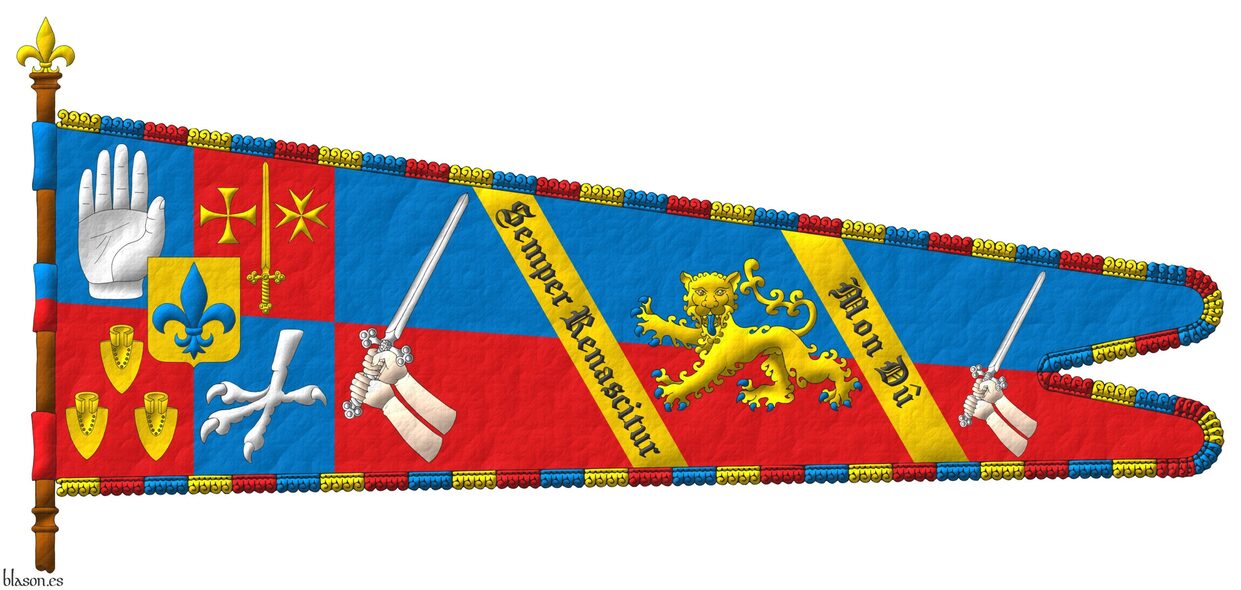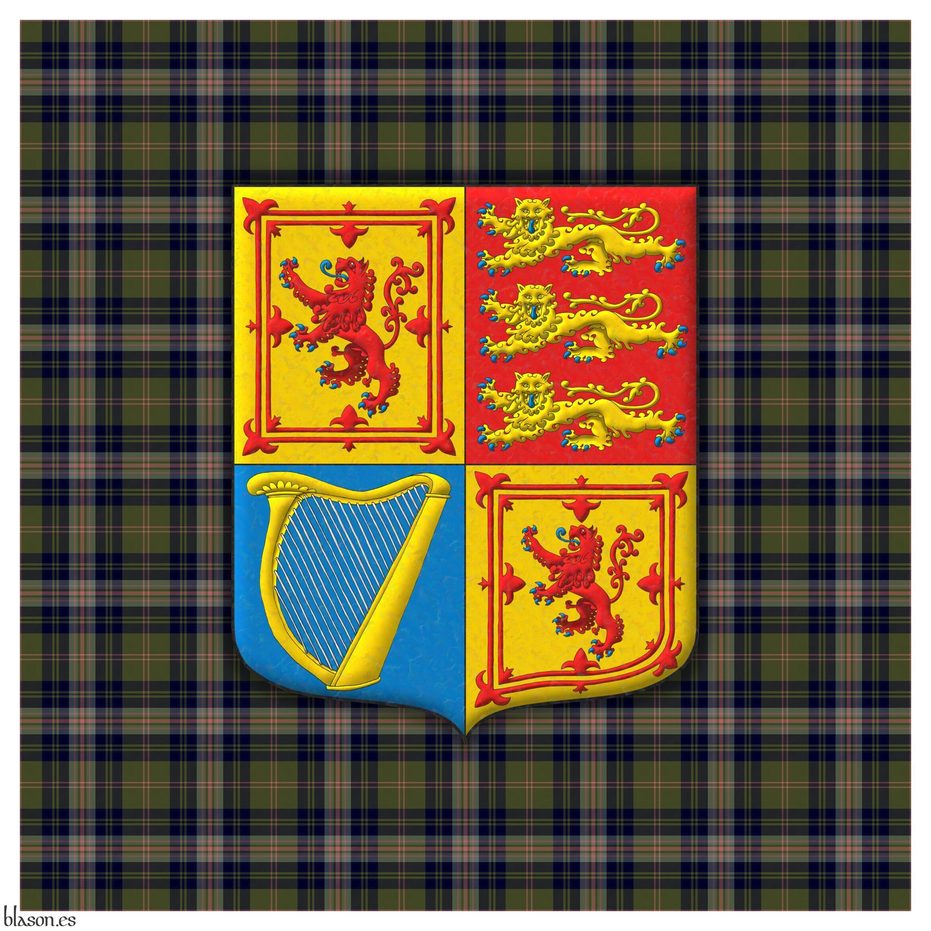Leopard


![Ver [Ailes, A.; 1982] en referencias bibliográficas. Libro abierto, hojas de plata, filo de oro, guardas de gules, tapas de sable.](../css/Libro.Bibliografia.png)
Ailes, A.; 1982
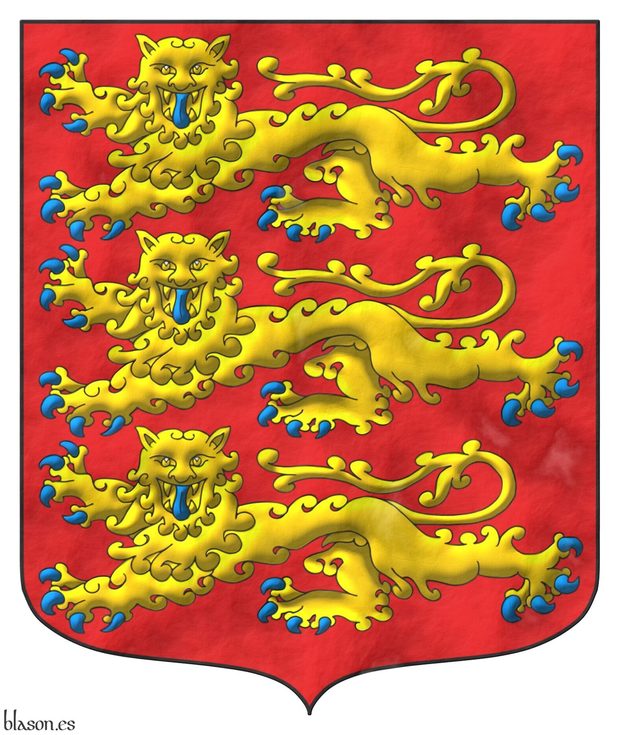
Adrian Ailes, «The Origins of the Royal Arms of England: Their Development to 1199», foreword by Rodney Dennys, includes 27 black and white illustrations, Graduate Centre for Medieval Studies, Reading University, 126 pages, ISBN 07-049077-6-3, Reading, Berkshire, 1982.
An article reviewing this book is: Brigitte Bedos Rezak, Archives nationales de Paris and Metropolitan Museum of Art, «The Origins of the Royal Arms of England, their Development to 1199 by Adrian Ailes», Speculum, volume 60, number 2, pages 373-376, Medieval Academy of America, Cambridge, Massachusetts, April of 1985.
Bibliographical reference of century XX.
The author is Ailes, Adrian.
Bibliographical reference mentioned in the following article:
External resource:


British Monarchy

Quarterly: 1 and 4 Gules, three lions passant, guardant, in pale Or, armed and langued Azure; 2 Or, a lion rampant Gules, armed and langued Azure, within a double tressure flory counterflory Gules; 3 Azure, a harp Or, stringed Argent.
Escudo cuartelado: 1o y 4o de gules, tres leopardos en palo de oro, lampasados y armados de azur; 2o de oro, un león de gules, armado y lampasado de azur, encerrado en un trechor doble flordelisado y contraflordelisado de gules; 3o de azur, un arpa de oro cordada de plata.
Arms depicted by me, highlighted with lights and shadows, outlined in Sable, with an ogee external shape and with a leather finish.
These are arms of the British Monarchy emblazoned by me.
Blazon keywords: Gules, Or, Azure, One, Three, Quarterly, Leopard, Pale, Armed, Langued, Lion, Rampant, Double tressure, Flory, Counterflory, Harp and Stringed.
Style keywords: Outlined in sable, Illuminated, Ogee and Leather.
Classification: Civic, Interpreted, Boa and Coat of arms.
Bearer: British Monarchy.


Crown of Her Majesty Queen Elizabeth II of the United Kingdom

Quarterly: 1 and 4 Gules, three lions passant, guardant, in pale Or, armed and langued Azure; 2 Or, a lion rampant Gules, armed and langued Azure, within a double tressure flory counterflory Gules; 3 Azure, a harp Or, stringed Argent. Crest: A crown proper.
Arms interpreted by me, illuminated with lights and shadows, outlined in Sable, with an ogee external shape and with a freehand finishing.
Coat of arms of Her Majesty Queen Elizabeth II emblazoned by me. Saint Edward Crown, the fundamental piece used in the anointing ceremony of British monarchs, was reconstructed in 1661 after the Restoration. This crown is distinguished by its four depressed or downward-curving arches, three visible, which rise from a circular base decorated with four cross patty, three visible, alternating with four fleurs de lis, two visible. Like the Tudor, its arches, adorned with pearls, converge at the center to support an orb, a cross on a world. The crown's base is lined with ermine, and the cap or inner lining is traditionally represented in Purple. It is the heaviest piece among the Crown Jewels and its use is reserved exclusively for the culminating moment of the coronation. The main visual difference between Saint Edward Crown and the Tudor Crown lies in their arches: Saint Edward Crown features depressed arches or downward curves, and its inner cap is typically represented in Purple. Conversely, the Tudor Crown features ascending or semi-circular arches, and its inner cap is colored Gules.
Blazon keywords: Gules, Or, Azure, One, Three, Quarterly, Leopard, Pale, Armed, Langued, Lion, Rampant, Double tressure, Flory, Counterflory, Harp, Stringed, Saint Eduard crown, Closed royal crown and Crown.
Style keywords: Outlined in sable, Illuminated, Ogee and Freehand.
Classification: Personal, Interpreted, Boa and Coat of arms.
Bearer: Elizabeth II of the United Kingdom.


Edmund Plantagenet
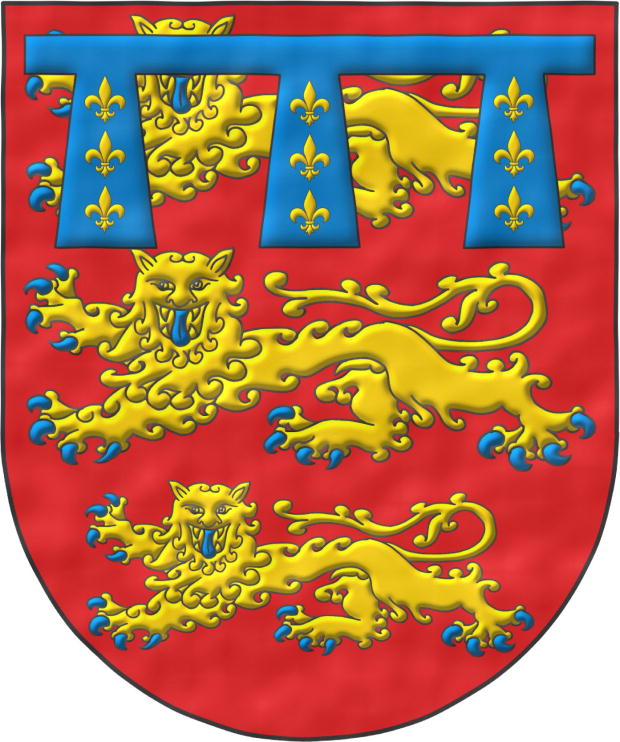
The one with the Cross on his back ~ Crouchback (1245–1296)
Arms of England; overall, a label Azure of three points, each charged with three fleurs-de-lis Or in pale.
Arms interpreted as follows: the mouth of the shield is semicircular (round); the field enamelled in a flat tint of Gules; the label and figures illuminated in Or and Azure and outlined in Sable; and the whole finished with a watercolour effect.
He was the second son of King Henry III of England, and took part in the Ninth Crusade, hence the epithet «Cross on the back».
In 1253 he was appointed Earl of Chester, holding dominion, among others, over the county of Cheshire, but the following year Pope Innocent IV granted him the crown of Sicily, so he ceded his earldom to his elder brother Edward I of England, however, he never came to occupy the throne of Sicily.
The label is an honourable ordinary and also «a kind of mark of cadency, and the most noble of all those used to differentiate the Arms of the younger sons of a House» [Avilés, J.; 1725a; page 248] and it can likewise be used by the eldest son while his father's arms are still in use, ceasing to bear the label when he inherits his father’s coat. When both the eldest and the second son bear a label, the latter’s label then has more points or is charged with figures to distinguish it.
The label is constructed with «a fillet, which is one-ninth of the width of the chief, with three pendants in the form of carpentry wedges or ill-shaped triangles, joined to it without any line of separation, falling twice as far as the fillet is wide, two placed at the ends and one in the middle, its usual position being in the centre of the chief’s length, without reaching the edges of the shield» [Avilés, J.; 1725a; page 248].
Blazon keywords: Without divisions, Gules, Or, Azure, Three, Leopard, Armed, Langued, In pale, Surmounted, Overall (deprecated), Label, Suspended, Charged and Fleur de lis.
Style keywords: Semi-circular, Illuminated, Outlined in sable and Watercolor.
Classification: Interpreted, Personal, Coat of arms, House of Plantagenet and Kingdom of England.
Bearer: Edmund Plantagenet.


Edward II of England
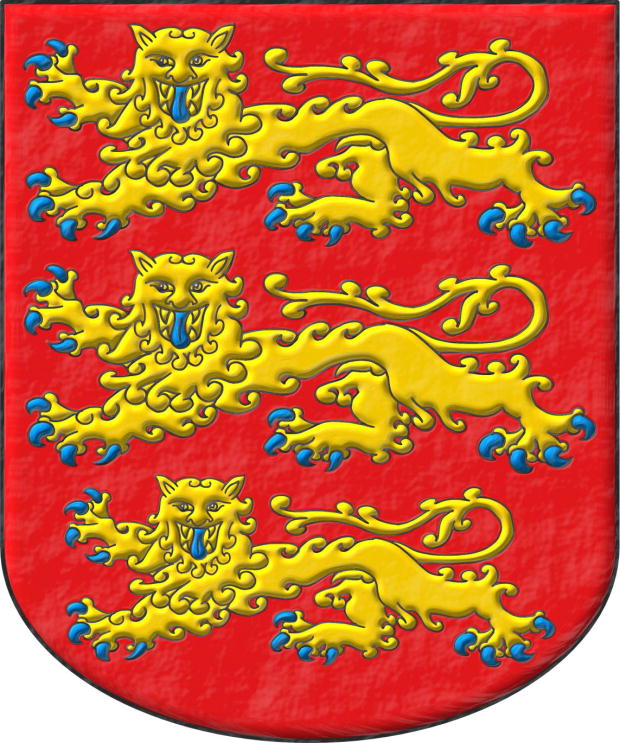
First Prince of Wales from 1301 to 1307, King of England and Lord of Ireland from 1307 to 1327.
Gules, three lions, passant, guardant, in pale Or, armed and langued Azure.
Escudo de gules, tres leopardos en palo de oro, armados y lampasados de azur.
Coat of arms interpreted as follows: the mouth rounded; the field illuminated Gules; the figures illuminated in Or and Azure, outlined in Sable, and the third leopard slightly smaller; and the whole finished with a plastered effect.
Blazon keywords: Without divisions, Gules, Or, Azure, Three, Leopard, Armed, Langued and In pale.
Style keywords: Rounded, Illuminated, Outlined in sable and Gesso.
Classification: Interpreted, Personal, Coat of arms, House of Plantagenet and Kingdom of England.
Bearer: Edward II of England.


![Ver [Edward IV of England; 1461] en referencias bibliográficas. Libro abierto, hojas de plata, filo de oro, guardas de gules, tapas de sable.](../css/Libro.Bibliografia.png)
Edward IV of England; 1461
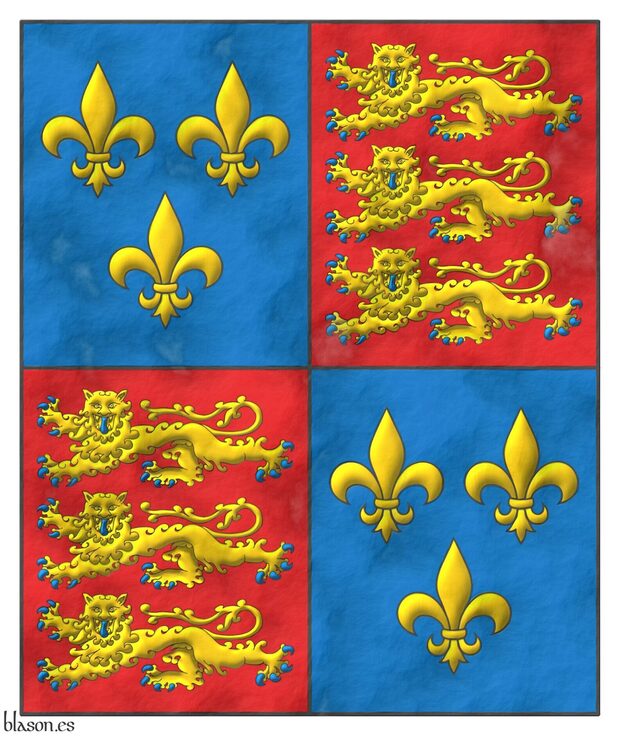
Edward IV King of England and Lord of Ireland, «The Armorial of Edward IV», «The Edward IV Roll», armorial in the form of a roll about 6 meters long, created to celebrate the coronation of Edward IV as the first King of England from the House of York and illustrated, probably, by different artists, 1461.
The image illustrating this reference corresponds to the banner, which is number 27 in the 2nd column, the final one of this armorial. This banner is held by a white deer, which was a personal badge of King Richard II of England, and also, two white deer were the supporters of his shield. The reason for the inclusion of this white deer might be to contribute to the legitimization of Edward IV as king.
It is notable that in row 25 of the 2nd column of this armorial there is a banner with the arms of the shield of Castilla y León, probably because Edward IV, like his predecessors, claimed their throne. In this version of the shield of Castilla y León:
- The two gold castles, in the 1st and 4th quarters of gules, have three towers with the central one taller like the Castilian, but the twin side towers seem to be connected by the wall as in the English castle, [Valero de Bernabé, L.; 2009a; page 2] and [Valero de Bernabé, L.; 2009b; page 33], the wall has a door that is enameled in azure as in the Castilian.
- The two lions, in the 2nd and 3rd quarters of silver, seem to be gold, therefore, of «metal on metal» and, furthermore, very different from the purple lion of Castilla y León, it could well be an error by the artist or a degradation of an original purple enamel to ochre, as explained in the pendón de Castilla y León.
This shield of Castilla y León also appears:
- On the banner in row 27 of the 1st column of this armorial. In this banner, they are combined with the arms of England represented in this article, in a new quartered, under an escutcheon with the imaginary arms of «Brutus of Troy», the also imaginary founder and king of Britain.
- On the caparison of the horse that Edward IV rides in the portrait at the beginning of his armorial. This caparison is a reproduction of the previous banner in row 27 of the 1st column that combined the arms of England with those of Castilla y León. The presence of these arms in this initial portrait of the armorial of Edward IV denotes the importance he gave to his aspirations to the crown of Castilla y León.
Bibliographical reference of century XV.
Author: Edward IV of England.
Here are the articles quoting this reference:
- Banner of Castile and León
- Brutus of Britain
- Brutus of Britain, banner
- Charles V of France
- Edward IV of England
- Edward IV, armorial for His coronation
- Edward IV, quartered con Castile and León
- Heraldica Nova
- King Arthur, 3 crowns in pale
- King Arthur, banner with 3 crowns in pale
- King Arthur, banner with cross flory
- King Arthur, cross flory
- Leonor de Aquitania
- Pendón con inescutcheon de Edward IV
External links:


Edward Longshanks

King of England and Lord of Ireland from 1272 to 1307.
Gules, three lions, passant, guardant, in pale Or, armed and langued Azure.
Escudo de gules, tres leopardos en palo de oro, armados y lampasados de azur.
Coat of arms interpreted with the following features: the mouth is semicircular (round); the field enamelled in a flat tint of Gules; the three leopards illuminated in the metal Or and the colour Azure, outlined in Sable, and the leopard closest to the base has a different shape and size; and the whole finished with a fabric-like texture.
Blazon keywords: Without divisions, Gules, Or, Azure, Three, Leopard, Armed, Langued and In pale.
Style keywords: Semi-circular, Illuminated, Outlined in sable and Fabric.
Classification: Interpreted, Personal, Coat of arms, House of Plantagenet and Kingdom of England.
Bearer: Edward I of England.


England, Kingdom of
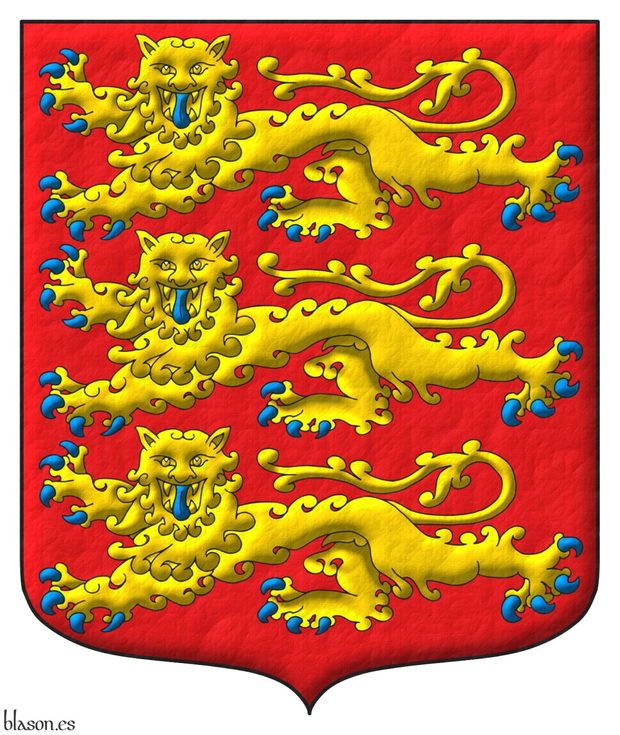
Gules, three lions passant, guardant, in pale Or, armed and langued Azure.
Escudo de gules, tres leopardos en palo de oro, armados y lampasados de azur.
Coat of arms interpreted by me, highlighted with lights and shadows, outlined in Sable, with an ogee external shape and with a leather finishing.
These are arms of the Kingdom of England emblazoned by me.
Blazon keywords: Gules, Or, Azure, Three, Leopard, Pale, Armed and Langued.
Style keywords: Outlined in sable, Illuminated, Ogee and Leather.
Classification: Civic, Interpreted, Boa and Coat of arms.
Bearer: England, Kingdom of.


Henry III of England
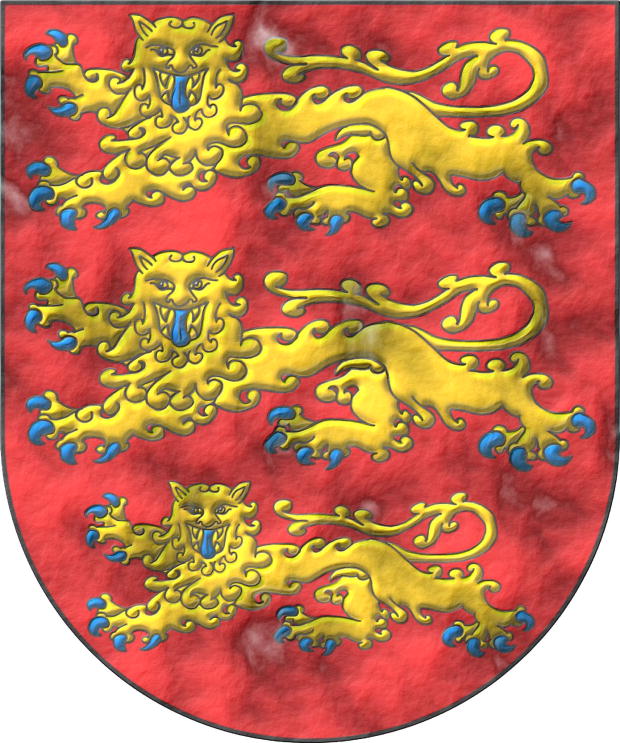
King of England, Lord of Ireland and Duke of Aquitaine from the year 1216 to the year 1272
Gules, three lions, passant, guardant, in pale Or, armed and langued Azure.
Escudo de gules, tres leopardos en palo de oro, armados y lampasados de azur.
Coat of arms interpreted as follows: the mouth of the shield is semicircular (round); its field has been enamelled in a flat tint of Gules; its leopards are illuminated in Or and Azure and outlined in Sable; and the whole has a finish of aged parchment.
Blazon keywords: Without divisions, Gules, Or, Azure, Three, Leopard, Armed, Langued and In pale.
Style keywords: Semi-circular, Illuminated, Outlined in sable and Old parchment.
Classification: Interpreted, Personal, Coat of arms, House of Plantagenet and Kingdom of England.
Bearer: Henry III of England.


![Ver [Humphery-Smith, C.; 1983] en referencias bibliográficas. Libro abierto, hojas de plata, filo de oro, guardas de gules, tapas de sable.](../css/Libro.Bibliografia.png)
Humphery-Smith, C.; 1983
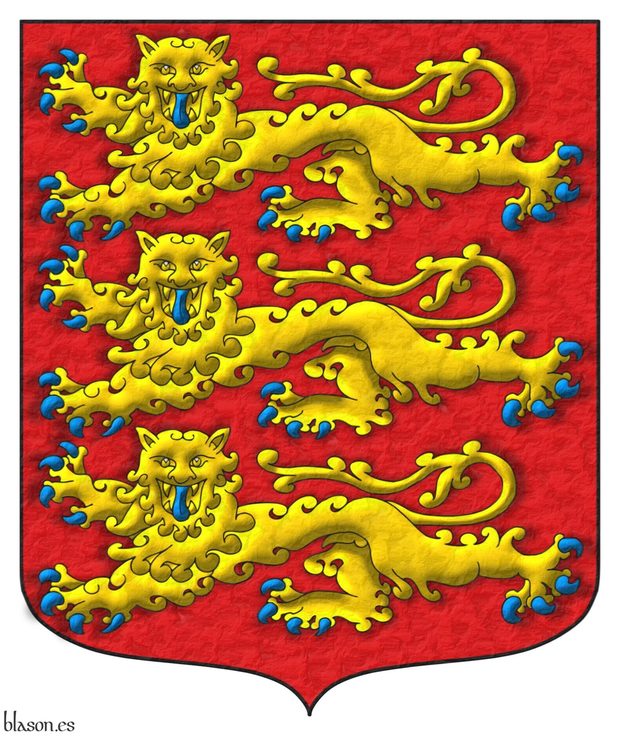
Cecil Humphery-Smith, FHS - Fellow of The Heraldry Society, «Why three Leopards?», Coat of Arms, COA, An Heraldic Quarterly Magazine, issue 126, The Heraldry Society, Baldock, Hertfordshire, summer of 1983.
The coat of arms illustrating this bibliographic reference is that of the Kingdom of England, which was also that of the queen of Castile Leonor Plantagenet.
Bibliographical reference of century XX.
Author: Humphery-Smith, Cecil.
Here are the articles quoting this reference:
External link:
Internal resources: HumpherySmithC1983.3Leopards.docx.


Jacques William Normand Delfin
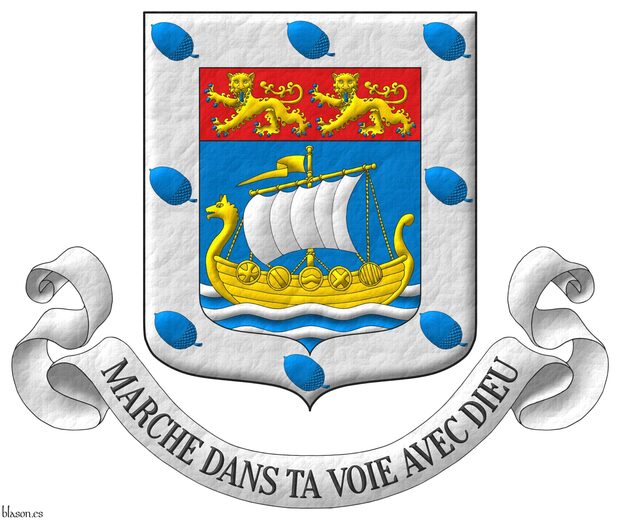
Azure, on three bars wavy Argent, a Norman ship Or, full sail Argent; on a chief Gules, two leopards Or, armed and langued Azure; a bordure Argent charged with eight acorns bendwise Azure. Motto: «Marche dans ta voie avec Dieu».
Escudo de azur, en punta tres burelas ondadas de plata sumadas de un barco normando de oro con vela de plata; en un jefe de gules, dos leopardos de oro, armados y lampasados de azur; una bordura de plata cargada de ocho bellotas puestas en banda de azur. Lema: «Marche dans ta voie avec Dieu».
Arms devised by me, illuminated with lights and shadows, contoured in Sable, with an ogee outer contour and with a leather finish.
Coat of arms of Dr. Jacques William Normand Delfin. He is from Mexico and his family comes from Falaise in Normandy. This coat of arms has been created by him and me, and emblazoned by me.
Blazon keywords: Azure, Argent, Or, Gules, One, Two, Eight, In base, On, Wavy, Bar, Norman ship, Full sail, Chief, Leopard, Armed, Langued, Bordure, Acorn, Bendwise and Motto.
Style keywords: Outlined in sable, Illuminated, Ogee and Leather.
Classification: Personal, Created, Boa, Coat of arms and Flag.
Bearer: Normand Delfin, Jacques William.


John I of England
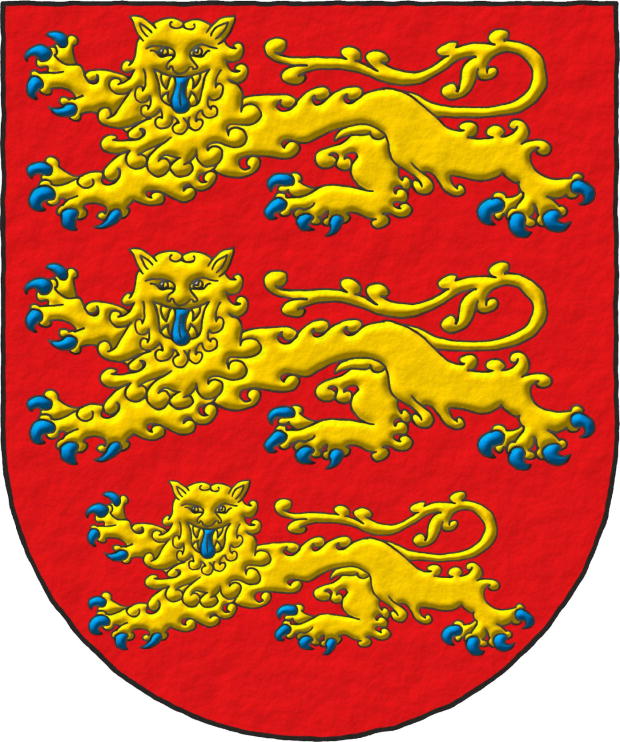
John Lackland ~ Juan sin Tierra ~ Sans-Terre.
Gules, three lions, passant, guardant, in pale Or, armed and langued Azure.
Escudo de gules, tres leopardos en palo de oro, armados y lampasados de azur.
Existing arms interpreted as follows: the mouth of the coat of arms is semicircular (round); the field has been enamelled in a flat tint of Gules; the three leopards are outlined in Sable and illuminated in Or and Azure; and the whole is executed with a raised-stroke effect.
Regarding this version of the shield of John I, [Humphery-Smith, C.; 1983] writes that «Richard's younger brother John... bore two lions because he was a junior member of the Plantagenet line», thus showing his belonging to a second level of the ruling family, although, after his brother Richard I of England, he not only ended up being king but it was also his line of succession that continued to reign in England.
Blazon keywords: Without divisions, Gules, Or, Azure, Three, Leopard, Armed, Langued and In pale.
Style keywords: Semi-circular, Illuminated, Outlined in sable and Freehand.
Classification: Interpreted, Personal, Coat of arms, House of Plantagenet and Kingdom of England.
Bearer: John I of England.


Juchter van Bergen Quast, Rudolph Andries Ulrich
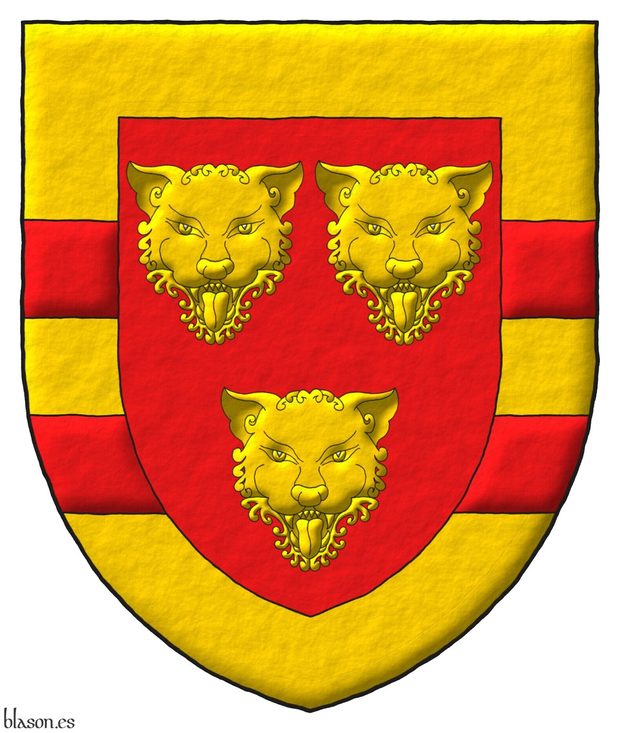
Gules, three Leopards faces Or, the whole within a Border Or with two Bars Gules.
Escudo de gules, tres cabezas de leopardo de oro; una bordura de oro con dos burelas de gules.
Interpreted coat of arms: with a pointed shape; illuminated with metal or and color gules; outlined with sable; and a freehand finish.
Blazon keywords: Gules, Three, Head, Leopard, Or, Ordered, Bordure, Two and Bar.
Style keywords: Freehand, Pointed, Illuminated and Outlined in sable.
Classification: Coat of arms, Interpreted and Personal.
Bearer: Juchter van Bergen Quast, Rudolph Andries Ulrich.


Leonor de Aquitania, escudo redondeado

Gules, a lion passant, guardant Or.
Escudo de gules, un leopardo de oro.
Arms interpreted by me with: the shape of the coat of arms rounded; the field illuminated in Gules; the leopard illuminated in Or, outlined in Sable, and shaded; and the whole composition finished with a marble texture.
A description of the leopard in heraldry can be found in [Medél, R.; 1846; page 38].
Blazon keywords: Without divisions, Gules, One, Leopard and Or.
Style keywords: Rounded, Illuminated, Outlined in sable and Marmoreal.
Classification: Interpreted, Personal, Coat of arms, Duchy of Aquitaine, Kingdom of France and Kingdom of England.
Bearer: Leonor de Aquitania.


Leonor Plantagenet

Gules, three lions, passant, guardant, in pale Or, armed and langued Azure.
Escudo de gules, tres leopardos en palo de oro, armados y lampasados de azur.
Existing armorial bearings interpreted as follows: the shape of the shield is pointed and rounded; the field has been enamelled in flat Gules; the three leopards are outlined in Sable and illuminated in metal Or with details in Azure; and the whole composition has a watercolor finish..
In [Humphery-Smith, C.; 1983; paragraph 2] the coat of arms of Eleanor Plantagenet, Queen Consort of Castile, is described, as part of an analysis on the origin of the three leopards in the coat of arms of England. However, in this description, an error is made by replacing the V with an X in the numeral of her husband and king, thus naming Alfonso VIII of Castile as if he were King Alfonso XIII: «Eleanor who married Alfonso XIII, King of Castile and Leon, has depicted on her tomb in the Huelgas monastery of the Cistercian nuns at Burgos, a thirteenth-century shield depicting three crowned leopards (lions passant guardant) gold on red».
Blazon keywords: Without divisions, Gules, Or, Azure, Three, Leopard, Armed, Langued and In pale.
Style keywords: Ogee, Illuminated, Outlined in sable and Watercolor.
Classification: Interpreted, Personal, Coat of arms, House of Plantagenet, Kingdom of England and Kingdom of Castile.
Bearer: Leonor Plantagenet.


Marc Eschenlauer
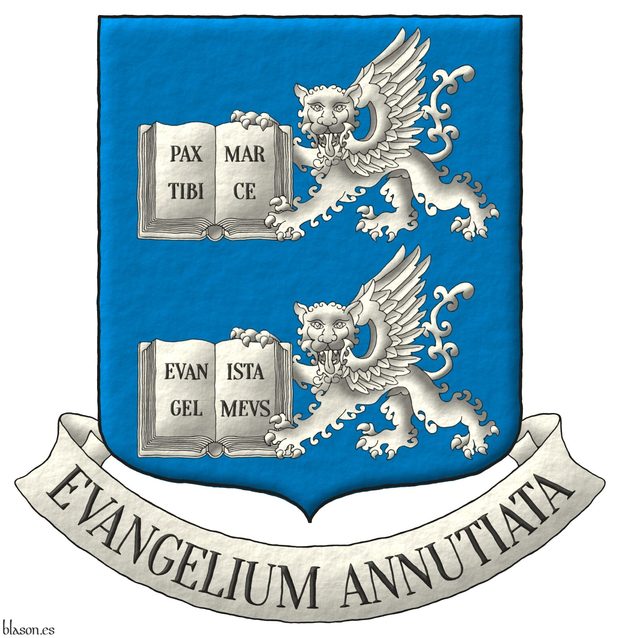
Azure, two lions passant, guardant, winged, each holding in its paws an open book Argent, with the inscription «Pax Tibi Marce Evangelista Meus» Sable distributed on their four pages. Motto: «Evangelium Annutiata».
Escudo de azur, dos leopardos alados, teniendo cada uno en sus garras un libro abierto todo de plata, con la inscripción «Pax Tibi Marce Evangelista Meus» de sable distribuida en sus cuatro páginas. Lema: «Evangelium Annutiata».
Coat of arms designed by me, illuminated with lights and shadows, contoured in Sable, with an ogee outer contour and with a freehand finishing.
Blazon keywords: Azure, Argent, Sable, Two, One, Four, Leopard, Winged, Grasping, Paw, Closed book, Book, Inscribed, Page and Motto.
Style keywords: Outlined in sable, Illuminated, Ogee and Freehand.
Classification: Religious, Created, Boa and Coat of arms.
Bearer: Eschenlauer, Marc.


Pendón con inescutcheon de Edward IV

Banner quarterly of sixteen: 1, 6, 11, and 16 Azure, three fleurs de lis Or; 2, 5, 12, and 15 Gules, three lions, passant, guardant, in pale Or, armed and langued Azure; 3, 8, 9, and 14 Gules, a castle triple towered Or, port and windows Azure, masoned Sable; 4, 7, 10, and 13 Argent, a lion rampant Purpure, armed and langued Gules, crowned Or; an inescutcheon Azure, three crowns in bend, bendwise Or.
Pendón cuartelado de dieciseis: 1o, 6o, 11o y 16o de azur, tres flores de lis de oro; 2o, 5o, 12o y 15o de gules, tres leopardos en palo de oro, armados y lampasados de azur; 3o, 8o, 9o y 14o de gules, un castillo de oro, aclarado de azur, mazonado de sable; 4o, 7o, 10o y 13o de plata, un león rampante de púrpura, armado y lampasado de gules, coronado de oro; un escuson de azur, tres coronas en banda, puestas en banda de oro.
Banner interpreted as follows: with the 5x6 proportions of a shield; the field, including that of the escutcheon, is enamelled with flat tinctures Gules and Azure; the crowns, castles, fleurs-de-lis, and leopards are outlined in Sable; except the lions, which are outlined in their field; and the whole composition is watercoloured.
In the armorial [Edward IV of England; 1461; row 27, 1st column, final banner], these arms appear twice:
- At the beginning, in the equestrian portrait of Edward IV, on the caparison of his horse.
- In the final banner held by Edward IV’s personal badge, a «White Lion of March».
Blazon keywords: Quarterly, Azure, Or, Three, Fleur de lis, Ordered, Gules, Leopard, Armed, Langued, In pale, Sable, One, Castle, Port and windows, Masoned, Argent, Purpure, Lion, Rampant, Crowned, Inescutcheon, Crown, In bend and Bendwise.
Style keywords: Rectangular, Illuminated, Outlined in sable, Outlined in the field tincture and Watercolor.
Classification: Interpreted, Personal, Flag, Banner of arms, Kingdom of England and House of York.
Bearer: Edward IV of England.


![Ver [Rabbow, A.; 1999] en referencias bibliográficas. Libro abierto, hojas de plata, filo de oro, guardas de gules, tapas de sable.](../css/Libro.Bibliografia.png)
Rabbow, A.; 1999

Arnold Rabbow, «The Origin of the Royal Arms of England - a European Connection», Coat of Arms, COA, An Heraldic Quarterly Magazine, número 186, The Heraldry Society, Baldock, Hertfordshire, verano de 1999.
This bibliographical reference is illustrated wit the coat of arms of the Kingdom of England interpreted by me with the with a semi-circle shape.
Bibliographical reference of century XX.
The author is Rabbow, Arnold.
Bibliographical reference mentioned in the following article:
External link:
Internal resources: RabbowA1999.OriginRoyalArmsEnglandEuropeanConnection.docx.


Standard of Laurent Liu-Lecomble
Heraldic device designed by me, illuminated with lights and shadows, outlined in Sable, and with a leather finish.
This is the heraldic standard of Laurent Liu-Lecomble, designed by him and me, and emblazoned by me. Structure: coat of arms; from his badge, the two arms bendwise proper, grasping a sword bend sinisterwise; motto «Semper renascitur»; a leopard Or, armed and langued Azure; warcry «Mon dû»; from his badge, the two arms bendwise grasping a sword bend sinisterwise.
Blazon keywords: Azure, Argent, Gules, Or, One, Two, Three, Quarterly, Dexter, Hand, Appaumée, Sword, Point upwards, Between, Cross patty, Cross couped, Sinister, Eight-pointed cross, Plough share, Affronty, Disordered, Eagle claw, Inescutcheon, Charged, Fleur de lis, Arm, Bendwise, Proper, Grasping, Bend sinisterwise, Motto, Leopard, Passant, Armed, Langued and War cry.
Style keywords: Outlined in sable, Illuminated and Leather.
Classification: Personal, Created, Boa, Standard and Flag.
Bearer: Liu-Lecomble, Laurent.


Stowe, Richard Allen
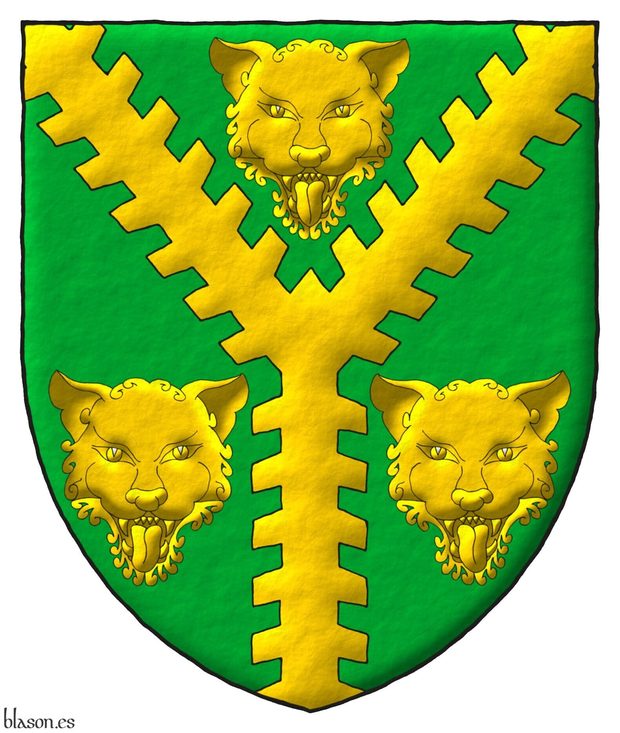
Vert, a pall raguly Or between three leopards' faces Or.
Interpreted coat of arms: with a pointed shape; illuminated with metal or and color vert; outlined with sable; and a freehand finish.
Blazon keywords: Vert, One, Pall, Raguly, Or, Three, Head and Leopard.
Style keywords: Illuminated, Watercolor, Pointed and Outlined in sable.
Classification: Coat of arms, Interpreted and Personal.
Bearer: Stowe, Richard Allen.


The Heraldry Society, schema
The coat of arms of The Heraldry Society emblazoned by me in 4 steps: 1) ratios, 2) delineation, 3) plain tincture, and 4) lights and shadows. Blazon: Quarterly Azure and Gules; overall a leopard face, crowned Or, langued Gules, within a tressure flory Or.
Blazon keywords: Quarterly, Azure, Gules, Overall, Head, Leopard, Crowned, Or, Langued, Within, Tressure and Flory.
Style keywords: Pointed, Illuminated, Outlined in sable, Shaded and Freehand.
Classification: Interpreted, Socioeconomic, Coat of arms and Schema.
Bearer: The Heraldry Society.


![Ver [The Heraldry Society; 2013] en referencias bibliográficas. Libro abierto, hojas de plata, filo de oro, guardas de gules, tapas de sable.](../css/Libro.Bibliografia.png)
The Heraldry Society; 2013

The Heraldry Society, «Education Pack, A brief explanation of Heraldry for teachers together with explanatory sheets and templates for students», Baldock, Hertfordshire, 2013.
This bibliographical reference is illustrated with the quartered coat of arms of The Heraldry Society.
Bibliographical reference of century XXI.
The author is The Heraldry Society.
Bibliographic reference mentioned in the following articles:
- Balaguer, municipality of
- Chequey, chequy or checky
- Drawing the arcs of a pointed coat of arms
- Geoffrey Plantagenet
- Savoy, Duchy of
External link:
Internal resources: TheHeraldrySociety2013.EducationPack.pdf.


The King Charles III in Scotland and the King Charles III Tartan
Quarterly: 1 and 4 Or, a lion rampant Gules, armed and langued Azure, within a double tressure flory counterflory Gules; 2 Gules, three lions passant, guardant, in pale Or, armed and langued Azure; 3 Azure, a harp Or, stringed Argent.
It has been interpreted by me, illuminated with lights and shadows, outlined in Sable, with an ogee outer contour and with a iridescent finish.
Coat of arms of His Majesty King Charles III in Scotland emblazoned by me, displayed over the known «King Charles III Tartan», registration 14030 at the Scottish Register of Tartans. It was created by the Scottish Tartans Authority for His Majesty on the occasion of his coronation, drawing from the sett of the Balmoral Tartan circa 1850, and features a central triple-stripe motif (one broad and two narrow) found in previous royal tartans worn by the King. Its palette, including green, blue and a soft red, has been matched to eighteenth-century natural-dye examples from the Scottish Tartans Authority collection.
Blazon keywords: Gules, Or, Azure, One, Three, Quarterly, Leopard, Pale, Armed, Langued, Lion, Rampant, Double tressure, Flory, Counterflory, Harp and Stringed.
Style keywords: Outlined in sable, Illuminated, Ogee and Iridescent.
Classification: Personal, Interpreted, Boa and Tartan.
Bearer: Charles III of the United Kingdom.
-
Language
-
Categories of heraldry
-
Divisions of the field
- Without divisions
- Party per pale
- Party per fess
- Party per bend
- Party per bend sinister
- Tierce
- Tierce sinister
- Tierced per pale
- Tierced per fess
- Tierced per bend
- Tierced pallwise inverted
- Quarterly
- Quarterly per saltire
- Gyronny
- Party per fess, the chief per pale
- Party per pale, the sinister per fess
- Party per fess, the base per pale
- Party per pale, the dexter per fess
- Chapé
- Chaussé
- Embrassé
- Contre-embrassé
- Party per chevron
- Enté
- Enté en point
- Flanched
-
Metals
-
Colours
-
Furs
-
Other tinctures
-
Ordinaries and sub-ordinaries
-
Diminutives of the ordinaries
-
Geometric charges
-
Composite ordinaries
-
Inanimate charges from Nature
Atom, Crescent, Diamond, Emerald, Estoile, Increscent, Lightning flash, Moon, Mount, Mullet, Mullet of four points, Orbital, Plough of Ursa Major, Rainbow, Ray of the sun, River, Sea, Snowflake, Sun, Sun in splendour, Sun of May, Trimount and Water.
-
Vegetal charges from Nature
Acorn, Apple, Apple tree, Ash, Bluebonnet, Camellia, Chrysanthemum, Cinquefoil, Cornflower, Dogwood flower, Double rose, Elm, Fleur de lis, Flower, Holm oak, Hop cone, Kapok tree, Laurel, Lily, Linden, Lotus flower, Madonna lily, Oak, Olive tree, Palm tree, Pomegranate, Poplar leaf, Rose, Shamrock, Sunflower, Thistle, Tree, Tulip, Vine and Wheat.
-
Animal charges from Nature
Badger, Bald eagle, Barbel, Barn owl, Bear, Beaver, Beetle, Bighorn sheep, Blackbird, Boar, Brach hound, Bull, Doe, Dog, Dolphin, Dove, Eagle, Elephant, Falcon, Fish, Flame, Fly, Fox, Frog, Goat, Goldfinch, Goose, Heron, Horse, Hummingbird, Jaguar, Lark, Leopard, Lion, Lion passant, Lion rampant guardant, Lioness, Lynx, Male figure, Martlet, Merino ram, Owl, Panther, Parrot, Peacock, Pelican, Pelican in her piety, Puffin, Quetzal, Raven, Roe deer, Rooster, Savage, Seagull, Serpent, She-wolf, Stag, Starling, Talbot, Tyger, Vulture, Warren hound and Wolf.
-
Parts of natural charges
Arm, Beak, Branch, Caboshed, Chest, Claw, Covert, Dorsal fin, Eagle claw, Ermine spot, Escallop, Feather, Foot (palmiped), Foreleg, Forepaw, Hand, Head, Heart, Hoof, Leaf, Neck, Ostrich feather, Palm frond, Paw, Roe deers' attires, Shoulder, Sprig, Stags' attires, Stem, Swallow-tail, Tail, Tail addorsed, Tail fin, Talon, Tooth, Trunk, Trunk (elephant), Two hands clasped, Two wings in vol, Udder, Wheat spike, Wing and Wrist.
-
Artificial charges
Ace of spades, Anchor, Anvil, Arch, Arm vambraced, Armillary sphere, Arrow, Axe, Bell, Bell tower, Beret, Bonfire, Book, Bookmark, Bow, Bridge, Broken, Buckle, Cannon, Cannon dismounted, Cannon port, Canopy roof, Carbuncle, Castle, Celtic Trinity knot, Chain, Chess rooks, Church, Clarion, Clay pot, Closed book, Club, Comb, Compass rose, Conductor's baton, Cord, Covered cup, Crozier, Crucible, Cuffed, Cup, Cyclamor, Dagger, Double vajra, Drum, Ecclesiastical cap, Fanon, Federschwert, Fleam, Four crescents joined millsailwise, Galician granary, Garb, Gauntlet, Geometric solid, Grenade, Halberd, Hammer, Harp, Host, Hourglass, Key, Key ward, Knight, Knot, Lantern, Letter, Line, Loincloth, Menorah, Millrind, Millstone, Millwheel, Monstrance, Mortar, Mullet of six points pierced, Nail, Non-classic artifact, Norman ship, Number, Oar, Oil lamp, Open book, Page, Pair of scales, Parchment, Pestle, Piano, Plough share, Polish winged hussar, Port, Portcullis, Potent, Quill, Ribbon, Rosette of acanthus leaves, Sabre, Sackbut, Sail, Scroll, Scythe, Sheaf of tobacco, Ship, Skirt, Spear, Spear's head, Stairway, Star of David, Step, Sword, Symbol, Tetrahedron, Torch, Tower, Trident, Trumpet, Turret, Two-handed sword, Wagon-wheel, Water-bouget, Wheel, Winnowing fan and With a turret.
-
Immaterial charges
Angel, Archangel, Basilisk, Dragon, Dragon's head, Garuda, Golden fleece, Griffin, Heart enflamed, Mermaid, Our Lady of Mercy, Ouroboros, Paschal lamb, Pegasus, Phoenix, Sacred Heart of Jesus, Saint George, Sea-griffin, Trinity, Triton, Unicorn, Winged hand and Wyvern.
-
External elements
-
Heraldic creations
-
References
-
Formats
-
Keywords on this page
Watercolor, Pointed, Armed, Harp, Azure, Flag, Bibliography, Boa, Bordure, Surmounted, Bar, Head, Charged, House of Plantagenet, Ogee, Counterflory, Stringed, Created, Quarterly, Outlined in sable, Two, In pale, Coat of arms, Fleur de lis, Flory, Personal, Gules, Illuminated, Interpreted, Langued, Motto, Leopard, Lion, Semi-circular, Ordered, Or, Pale, Leather, Argent, Without divisions, Bendwise, Rampant, Kingdom of England, Sable, Century XX, Freehand, Double tressure, Three and One.

